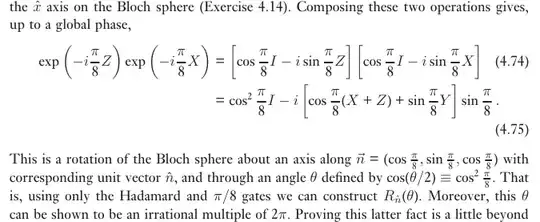How do we prove that $\theta$ is an irrational multiple of $2\pi$ given $\cos(\theta/2)\equiv \cos^2(\pi/8)$?
With $\operatorname{SU}(2)$ rotations,
\begin{align}R_z(\pi/4)R_x(\pi/4)&=[\cos(\pi/8)I-i\sin(\pi/8)Z][\cos(\pi/8)I-i\sin(\pi/8)X]\\ &=\cos^2(\pi/8)I-i[\cos(\pi/8)X+\sin(\pi/8)Y+\cos(\pi/8)Z]\sin(\pi/8)\\ &=\cos(\theta/2)I-i(\hat{n}.\vec{\sigma})\sin(\theta/2)=R_\hat{n}(\theta)\end{align}
where $\vec{n}=(\cos(\pi/8),\sin(\pi/8),\cos(\pi/8))$ and $\hat{n}=\frac{\vec{n}}{||\vec{n}||}$, and $\vec{\sigma}=(X,Y,Z)$ where $X,Y,Z$ are Pauli matrices. Thus $\cos(\theta/2)\equiv\cos^2(\pi/8)$ and $\sin(\theta/2)\equiv\sin(\pi/8)\sqrt{1+\cos^2(\pi/8)}$.
Original Context in my Reference
Ref. to Page 196, 214 of QC and QI by Nelsen and Chuang
Any hint on the possible ways to approach this could be appreciated.
